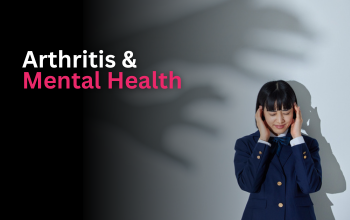Sun Smart Guide
Get the facts. Enjoy summer!
By Eileen Davidson, Arthritis Patient Advisory Board, Arthritis Research Canada
Warm weather is easier on the joints, but the sun can trigger unwanted symptoms in people living with different types of arthritis. For this reason, there are several factors to consider before catching some rays. Do you take medications that cause sun sensitivity? Do you have complications that make it difficult for you to handle heat?
No case of arthritis is the same. The sun may trigger symptoms for one person but relieve them for another. While warmer weather can reduce joint pain, people with arthritis can experience more pain and fatigue in the warmer months because many are more active and prone to overdoing it. So, to help people with arthritis navigate the heat ahead, we’ve put together a Sun Smart Guide.
Why do arthritis patients need to be sun smart?
- Many drugs used to treat arthritis – like nonsteroidal anti-inflammatory drugs (NSAIDs) (including topical versions), sulfa-containing drugs and antimalarials – can cause sun sensitivities. Naproxen appears to have the most photosensitizing potential of all the NSAIDs and is a common cause of sunburn reaction. Sunburn reaction from ibuprofen seems less common. The use of Celecoxib can cause a sun rash reaction.
- Hydroxychloroquine, an antimalarial, is another well-known cause of drug-induced sun sensitivity.
- Methotrexate does not cause sunburn. It can irritate areas where someone has had sunburns in the past.
- Some biologics containing an anti-TNF (tumor necrosis factor) agent (like etanercept, adalimumab, golimumab and infliximab) put people at an increased risk of developing skin cancer.

Lupus patients need to be extra sun safe because exposure to UV light can trigger an autoimmune reaction.
The type of ultraviolet (UV) rays that seem to cause the most problems in people with lupus are UVB rays because ultraviolet light is a type of invisible radiation that’s present in sunlight. This response can happen even through windows. It is important for lupus patients to wear sunscreen when in a well-lit room with large windows.
UVA radiation can also contribute to the following symptoms:
- lupus rash and lesions
- fatigue or weakness
- joint pain
- lupus flare
And it’s not just the sun that can cause this reaction. Artificial light with UV rays – including fluorescent lighting, photocopiers and tanning beds – can also cause problems for lupus patients.
Individuals with primary Sjogren’s syndrome who are exposed to direct sunlight can experience a similar autoimmune response that includes the following symptoms:
- rashes
- sensitivity to light
- sudden flare-ups in symptoms
Inflammatory arthritis patients must be aware of uveitis.
While not something caused by the sun, the sun or any bright light, will aggravate pain and discomfort in the eyes. Uveitis is common in those living with an autoimmune disease like rheumatoid arthritis, psoriatic arthritis, ankylosing spondylitis or juvenile idiopathic arthritis. Uveitis means inflammation that primarily affects the uvea, the middle layer of your eye, produces swelling in the eye and can destroy eye tissue over time if left untreated.
Uveitis presents itself in the following ways:
- redness and pain in the eye
- decreased, blurry vision with floaters
- sensitivity to light of any kind
If you are experiencing eye pain and live with inflammatory arthritis, ask your rheumatologist about uveitis.
It’s not just arthritis but comorbidities that can make people photosensitive too.
Comorbidity is the word used to describe the presence of two or more diseases or medical conditions in a patient at the same time. Diabetes, high blood pressure, heart disease and obesity are common comorbidities in people with arthritis. And they may have an impact on how individuals handle the sun and heat, especially if they are on medications like diuretics, oral diabetes drugs, and cardiac medications.
Psoriatic arthritis and the benefits of sun exposure
Unlike lupus, UV light makes psoriasis symptoms better. Patients with psoriatic arthritis often report that they feel better in the summer because being out in the sun reduces their psoriasis plaques. But they still need to be mindful of skin cancer and wear protection. This is especially important if on a biologic with an anti-TNF agent. UV light that has filtered out the harmful rays is an actual treatment for those with psoriasis.
There are three major reactions to the sun that all arthritis patients need to watch for.
Most common: Phototoxicity
- Appears as a bad sunburn minutes to hours after exposure.
- Higher doses of medication increases risk, as the drugs become activated by UV rays from the sun.
- Unexposed skin appears normal.
Less common: Photoallergic
- Not related to medication dose.
- Rash appears a day or more after sun exposure. In photoallergic reactions, UV exposure alters the structure of the drug so that the immune system views it as an antigen, thereby activating an allergic response.
- Can spread beyond sun-exposed skin.
After prolonged heat exposure: Heat stroke
- Caused from high body temperature with a core body temperature of 40C (104F) or higher.
- Symptoms of heat stroke include altered mental state or behavior, confusion, agitation, slurred speech and irritability. In severe cases, heat stroke can cause delirium, seizures and coma.
- Other symptoms include nausea, vomiting, flushed skin, rapid and shallow breathing and headache.
- Two forms of heat stroke include being brought on by hot weather, which makes your skin feel hot and dry to the touch. However, in a heat stroke brought on by strenuous exercise, your skin may feel dry or slightly moist.
- Racing heart rate: Your pulse may significantly increase because heat stress places a tremendous burden on your heart to help cool your body.
How those with arthritis can stay sun safe
When it comes to staying safe in the sun and heat, prevention is always key.
- Apply sunscreen regularly, even on cloudy days. Some sunscreens are more effective than others. Look for ones with titanium dioxide or zinc oxide and go for the highest concentration of SPF (30-60 SPF). Be sure to regularly apply every 2-3 hours, 15-30 minutes before sun exposure. If swimming or sweating profusely, add more often. It is suggested to use about an ounce of sunscreen, or a shot glass full to cover your entire exposed body.
- Skincare and makeup, like lip balms, powders and CC creams with SPF as an ingredient are wise to use on a daily basis and make reapplication easier.
- Use spray sunscreen for tired, achy shoulders and hands affected by arthritis or hard-to-reach areas.
- Wear large brimmed sun hats and large sunglasses.
- Source built-in sun protection in clothing – known as ultraviolet protection factor (UPF). Look for clothing that’s labeled with a UPF of 25 to 50 or higher.
- Everyone tolerates the sun differently, if you don’t tolerate it well, limit sun exposure to only a few minutes at a time and only go outside when shade is readily available. Avoid the sun between 10am and 4pm when the UV rays are strongest and the heat is highest. If you do go out, find shady areas to hang out in.
- Always stay hydrated.
What to do when you’ve had too much sun exposure
First, identify what form of reaction you are having. If you or someone you know is experiencing photosensitivity, phototoxicity or hyperthermia/heat stroke it is recommended to:
- Apply a cool compress to affected areas.
- Apply soothing lotions with ingredients like aloe vera or arnica for burns.
- Apply topical corticosteroids or antihistamines to affected areas if you have a rash.
- In the case of heatstroke, it is important to cool down in any way possible. This can be in a cool tub of water or a cool shower, spray with a garden hose, sponge with cool water, fan while misting with cool water, or place ice packs or cold, wet towels on your head, neck, armpits and groin.
- Rehydrate with water and electrolytes.
- Do not take NSAIDS medication if you experience nausea and vomiting or dehydration from sun exposure.
- If symptoms do not improve, seek care from a healthcare provider or visit the emergency room if urgent.
Curious about your risk for sun sensitivity or skin cancer because of your arthritis? Ask your rheumatologist and pharmacist for more information. You don’t need to avoid the sun because you have arthritis. You just need to be sun smart!




















































